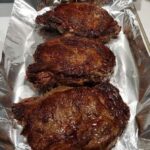Description
There are steaks, and then there’s the ribeye — the king of steaks, renowned for its rich marbling and deep flavor. Cooking the perfect ribeye steak is an art, one that any steak enthusiast dreams of mastering. If you’re ready to elevate your steak game to the next level, look no further. This ribeye steak recipe promises a mouthwatering experience that’s sure to impress, whether it’s a special occasion or a luxurious weeknight treat. Don’t lose this recipe; it might just become your go-to for a perfect steak every time.
Ingredients
- 2 ribeye steaks (about 1 to 1.5 inches thick)
- 2 tablespoons olive oil
- 1 teaspoon garlic powder
- 1 teaspoon onion powder
- 1 teaspoon paprika
- Salt and freshly ground black pepper, to taste
Instructions
Prepare the Steaks: Begin by letting your ribeye steaks sit at room temperature for about 30 minutes before cooking. This ensures they cook evenly.
Season: Mix the garlic powder, onion powder, paprika, salt, and pepper in a small bowl. Rub each steak with olive oil, then apply the seasoning mix generously on both sides.
Preheat Your Pan: Heat a cast-iron skillet or heavy-based pan over high heat until it’s smoking hot. The key to a perfect crust is a very hot pan.
Cook to Perfection: Place the steaks in the hot pan. For a medium-rare finish, cook for about 4-5 minutes on each side, depending on the thickness of your steak and your desired level of doneness. Use tongs to flip the steaks and to sear the edges.
Rest: Once cooked to your liking, transfer the steaks to a cutting board and let them rest for about 5-10 minutes. This allows the juices to redistribute throughout the meat, ensuring your steak is juicy and flavorful.
Serve: Slice against the grain and serve immediately. Enjoy the rich flavors and tender texture of your perfectly cooked ribeye steaks.
Notes
- Choosing Your Steak: Look for steaks with good marbling (fat running through the meat) as this contributes to the flavor and juiciness.
- To Flip or Not to Flip: While some chefs recommend flipping the steak only once, others suggest flipping it every minute for an even crust. Experiment to find your preferred method.
- Checking Doneness: Use a meat thermometer to ensure your steak is cooked to perfection. For medium-rare, aim for an internal temperature of 135°F (57°C).
Conclusion:
Cooking the perfect ribeye steak doesn’t require a culinary degree — just a good cut of meat, the right seasonings, and a bit of technique. With this simple yet exquisite recipe, you’re well on your way to achieving steakhouse-quality results in your own kitchen. Whether you’re celebrating a special occasion or simply indulging in a love of steak, this ribeye recipe is sure to satisfy your cravings and earn a permanent spot in your culinary repertoire.
Happy cooking, and may your steak be as flavorful and succulent as ever!
